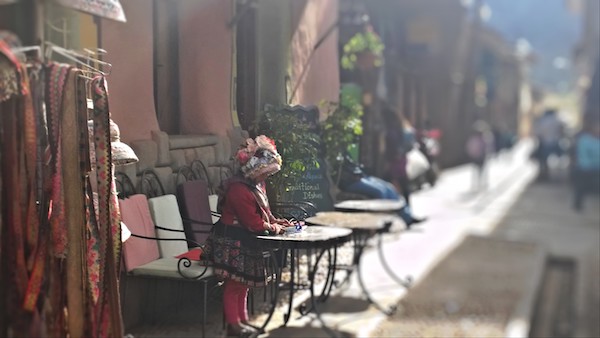How can you contribute to locals when you travel? Unfortunately the ways in which many people think they’re helping may actually be a hindrance to the local communities and their economies. This article will outline five pitfalls to avoid along with lots of tips to ensure the money you spend abroad goes to the right places.
Dear Nora,
I read somewhere that we do a lot of damage visiting developing countries. I thought spending money abroad was a good thing! What gives? – Nessa
While spending money abroad is generally a good thing, it’s a concept that needs (desperately) to be qualified. How and where you spend your money can make the difference between putting food on a local family’s table, and taking it away. Between local healthcare being available and affordable, and people dying unnecessarily. Between having a balanced and stable economy – and environment – and falling into chaos.
While I generally consider myself to be a socially and economically responsible traveller (years ago I wrote about how tourists unwittingly cripple local economies), the research I did for this article has been a real eye opener, and will change many of the spending decisions I make abroad going forward. Hopefully it will for you as well.
Here are five pitfalls to avoid that damage local economies and cultures, and ways around them so you can be a more responsible traveller.
Responsible Travel Pitfalls
Following are some activities you may like to partake in while you travel, but that can cause great harm – to locals, communities, economies, and the environment.
It’s worth noting that this article is focusing more on the economic/social/cultural impact of how you spend your money abroad, rather than on sustainable travel concepts, which are more environmentally focused – and which warrants an entire article unto itself. So while issues like reducing your carbon footprint and single-use plastics are incredibly important, for the most part these are beyond the scope of this article.
Voluntourism
There is a significant difference between the terms “volunteer” and “voluntourism”. Voluntourism is a hybrid of the words “volunteer” and “tourism” and generally entails a vacation with a small volunteer component built into a larger itinerary allowing participants to see the sights and engage in “tourist” activities. Unfortunately the positive impact of the volunteer component is diluted/nullified by the short duration and lack of applicable skills on the part of the participants. In some cases the entire experience is fabricated to make the participants feel good and part them with their money (neither for the benefit of the local communities).
Daniel Noll and Audrey Scott have more than 10 years as tourism development strategists, responsible travel advocates and marketing advisors, and they are the founders of the award-winning travel blog Uncornered Market.
“Often times, volunteering/voluntourism not only does unintended harm in communities, but purchasing a voluntourism experience often just means more money for a middleman and often quite little or none for the community it’s supposed to benefit.”
In this article, they provide questions to ask if you’re considering a volunteer organization.
They describe how they were volunteering in Haiti following the big earthquake. A tweet came in from a reader asking for some on-the-ground advice about safety.
I turned to Cyril, our Haitian guide, and asked, “What do you think?”
“I would advise her to be very careful, perhaps choose to do something else,” he said.
He wasn’t talking about her physical safety, though.
“Especially after the earthquake, many of these orphanages were set up just to make money from foreign volunteers. Traditionally in Haiti, we didn’t have orphanages. Once people realized they could make money from this, the orphanages began to appear. In some cases, the children there actually have parents.”
According to Daniel and Audrey, “The volunteer ‘industry’ is currently estimated at $2.8 billion in annual revenue, and is expected to grow as more people seek volunteer experiences each year.”
Despite our best intentions, sometimes it is better to let go of the desire to volunteer abroad and instead to spend our money consciously and in a way that will directly benefit locals. Later in this article we’ll provide some resources for you to do this.
Working/Volunteering in Orphanages
Volunteering in orphanages is an incredibly popular way for people to (try to) give back when they travel. Unfortunately, as already alluded to above, orphanages have become an industry, and an ugly one at that.
Luckily, a few global spotlights have illuminated this issue in the hopes of turning things around. According to the BBC in this article:
It is estimated 80% of children living in the world’s orphanages have at least one living parent. In many cases, they have been lured to the orphanages to attract volunteers.
According to the U.S. State Department, “many orphanages use the children to raise funds by forcing them to perform shows for or interact and play with potential donors to encourage more donations”.
Even in the most well-meaning of orphanages,…children are often unable to thrive due to the institutional environment, harming their development.
Interacting With/Giving to Children
Orphanages aside, don’t we all love the idea of connecting with local children? Of playing games with them, visiting them in schools, giving them candy, and – of course – getting the obligatory selfie with them? Beware: innocent as your intentions may be, the effects may be detrimental.
As a real eye-opener, Daniel and Audrey wrote a post about 10 Dos and Don’ts of Child Welfare in Travel, where they admit to a few having unwittingly made a few mistakes themselves.
If you don’t have children, imagine a child or young person who means a lot to you. Now, when you consider interactions and situations with local children you encounter during your travels, ask yourself:
‘Would I do the same thing with a child in my own country? Would I want a traveller to do this with my own child? Would it be OK if a traveller just walked up and did this with my family, my friends’ children, or my neighbours?’
When you think of it this way, scooping up a random child and putting them on your lap and taking selfies with them is downright offensive, if not abusive. When I was in India, I was initially flattered by the dozens of strangers every day who wanted selfies with me – only some of whom actually asked me, with many more who just did it without my permission. It didn’t take long before I felt like a zoo animal. Imagine how a child might feel.
Consider the matter of giving to a begging child. Perhaps not a monetary donation, but something like food or school supplies. While it’s hard to say no, or even to imagine that giving school supplies to a child could be a bad thing, there’s a chance (and a greater one than you may suspect) that the parents of that child could subsequently force them into begging, and even pull them out of school to do it (thus negating the whole intention on the traveller’s part in giving supplies).
The same goes for buying something from a child, using them as photo props in exchange for tips, and anything that involves conducting any sort of transaction with random children.
While your intention of helping children is likely a hands-on approach, this NY Times article suggests that you’ll effect much better changes if you drop the idea of “saving” people, step away from the baby, and help out in other ways.
Tiger Petting/Animal Selfies
Did you know that sloths as a species are becoming endangered because of the all the people taking selfies with them? Not only does the interaction with them affect their behaviour (according to World Animal Protection), but the influx of social media posts with these creatures has created a demand which has, in turn, resulted in more and more of them being abducted from the wild. And locals, seeing that the resulting tips are lucrative, are responding to this demand and making their livelihoods from it.
A friend of mine was travelling in Colombia and found herself in a situation where a sloth was thrust into her arms. She did as anybody might do and took some pictures. She felt okay about it, because she was told the sloth was an orphaned pet of the local family, and she felt this wasn’t a fabricated tourist experience. Knowing what I know now about this industry, I’m willing to bet this family did the same thing with every foreigner passing through, and given that 80% of orphaned humans actually have parents, I can only surmise that the orphaned sloth was taken from its own parents.
Just say no. The picture isn’t worth it.
Despite increasing awareness of these issues, it’s flabbergasting that tiger-petting experiences still exist – and even are “a thing” to do on Tinder. This, according to the Smithsonian:
It may seem obvious that keeping tigers drugged and chained to make them more amenable to selfie-taking is messed up. But it’s worse than you think. This practice harms not only individual tigers, but conservation efforts to protect the endangered wild cats worldwide.
While Thailand and its infamous temple have been the focus of the most recent tiger selfie controversies, there are plenty of places in the United States where people can and do take photos with the big cats. There are an estimated 5,000 tigers in private hands in the United States. That’s 10 times more than the number in accredited zoos and other institutions—and more than the some 3,900 tigers found in the wild globally.
As if you needed any more reasons not to get all cuddly with wild animals, there’s this, from the World Animal Protection via Africa Tourism TV:
Edith Kabesiime, the wildlife campaign manager WAP said, “People also transmit diseases like cough, flu when come closer to animals and animals also transmit diseases like Ebola to people.”
Elephant “Conservation”
There has been a lot of press in recent years about the exploitation of elephants – in all cases regarding riding them (again: just don’t do it. Ever), and even in some cases in “sanctuaries” that are glorified tourist traps where we think we’re helping the elephants, but instead are contributing to the cycle of captivity.
Thankfully, more and more countries are banning unethical elephant practices and instead finding better ways to help them while still providing tourists with the interaction and observation they crave.
But just because a place bills itself as a conservation centre, their practices may not be as ethical as promised. For my article on Travel Splurges, a fellow traveller thought she was volunteering at a proper elephant conservation centre, only to learn the experience was fabricated to collect tourist dollars.
How to Travel Responsibly
Having outlined some of the major pitfalls above, let’s now look at the ways you can ensure your money is going to the right people and making a positive difference while you travel. In almost every case, it’s a matter of doing your research, asking questions, and travelling/spending consciously.
Choose Where (and What) You Eat Wisely
Sam and Veren of Alternative Travelers focus their travels and their writing on techniques for travelling sustainably. As food bloggers, they eat out a lot, and have learned how to find restaurants that benefit locals instead of wealthy expats. Not only does that mean their money is responsibly spent, but in many cases the food is cheaper, and better!
According to Sam and Veren, research is important, but it doesn’t have to be a chore. Here are their tips:
“The number one thing we recommend is getting out of touristy squares and landmarks. Usually even a few blocks away you’ll be able to find local spots. Some key indicators for places to avoid include: big photos of food on signs out front, giant British or American flags proclaiming English language menus, and none of the local language being spoken by people eating there.”
Another winning tip is to ask locals what their favourite dishes are and where to get them. “Often, what foreigners think are local dishes are actually not! Case in point: paella in Spain. Paella is a local dish from the region of Valencia that takes hours to prepare, yet visitors want to be able to get a paella no matter where they are in Spain, and at every time of day (despite local dining hours). To meet that demand, companies mass-produce frozen paella to serve in touristy restaurants in bigger Spanish cities. Basically, it always pays to ask a local.”
Vet Companies Using Social Media
Zach Minnich and his wife recently returned from seven months in Sri Lanka, where they were connecting connecting sustainable businesses throughout the country through their Tuk Tuk Tournament Youtube Series.
“Many people just blindly follow the trail of cool shots they see on Instagram, without once thinking about their travel impact. I think just by being aware that you have an impact, you are a step in the right direction.”
When they find something they’d like to do, they vet the business by lurking their social media profiles. “You can tell pretty quickly where their values lie. A good sustainable business shouldn’t have any pictures of single use plastic, animal abuse (like elephant riding), they should mention supporting local small businesses, and have a majority local staff.”
Zach also discovered an organization in Sri Lanka called Good Market that is building a database of sustainable businesses. They are starting to expand this practice beyond Sri Lanka with an aim to create a new global economy featuring only sustainable businesses, and requiring an extensive screening process to be listed. “It will be great in a few years when they have a larger worldwide network and we can be sure that we are spending money in the right places without doing a lot of research.”
Book Tours With Companies That Give Back
While a lot of the advice in this article is about asking locals for suggestions and booking things locally on the spot, it’s not always possible if you are travelling with a short time-frame or have specific activities you wish to do that require more planning.
G Adventures is a great example of a tour company that gives back to local communities with every tour. They’ve even intensively examined how the money spent on their tours affects local communities, and they created a Ripple Score so you can see how beneficial the trip you wish to take really is for the local communities involved.
Your money is still ultimately being paid to a foreign tour company, but they are at least partially accountable for how it is spent, and are committed to giving back.
Bargain Sensitively
While I’m a big advocate of doing as the locals do (which includes bargaining), it’s possible to take it too far. At the same time, knowingly paying too much for something can sway people to the tourism industry from critical careers, thus unbalancing the local societal structure and economy. If you could earn more money doing an unqualified job in the tourism sector than you could as a teacher or doctor, then what’s the incentive to get the education required?
As a foreigner, you’re often charged more than locals pay for the same service or product. It happens all the time. It’s called “foreigner tax,” and yes, it’s frustrating.
But instead of moving to the opposite extreme and squabbling over cents, ask yourself how much a fair wage is for the person offering you the product or service at hand. Are you low-balling for the sheer sake of adhering to a travel budget that is in actual fact unrealistic for your destination or lifestyle? Remember: if you’re prepared to pay a few extra dollars for “fair trade” products at home, just think of how much further those few extra dollars could go in the hands of somebody who needs it.
Buy Locally-Made Souvenirs
If somebody could earn an above-average income selling mass-produced keychains to tourists, then once again, where is the incentive for that person to get an education and a job that allows them to be of service to their local economy? Even worse, what if these mass-produced keychains are undercutting local artisans (as they almost always do)?
Before you buy souvenirs abroad, check out a few stores/marketplaces. If you see the same item in more than one place, then chances are it’s mass-produced, regardless of what the vendor tells you. Also, if the price is “too good to be true”, it probably is.
Instead, research local markets and buy the “real thing” from a local artisan. You may pay a bit more, but your money will go a lot further.
Stay in Locally-Owned Hotels
Did you know that when you stay at an all-inclusive foreign-owned resort, as much as 90% of the money leaks back to the company’s headquarters abroad, rather than the local country? It’s called “tourism leakage” in the industry, and it’s not pretty.
Gabriela Sijer co-founded Rooms for Change after travelling to 60 countries and finding it difficult to do so in a low-impact way that contributes to local communities. “I quickly learned that one of the best ways to do that (and to get a much more authentic experience and more bang for your buck – win win) was to directly support local businesses, be it restaurants, hotels or locally made souvenirs. In this age of giant OTAs with millions of properties and the recent rise in popularity of vacation rentals, it has become increasingly difficult to find a locally owned good old HOTEL – and one with a soul and character at that.”
So now, with Rooms for Change, you can find hand-picked independent locally-owned properties, with the bonus that a portion of the profits of Rooms for Change are being donated to charities.
Try Homestays
Steph Dyson of Worldly Adventurer spent four years travelling through South America with a focus on volunteering and sustainable, responsible travel. She enjoyed homestay experiences in Guatemala, Peru, and Chile and discovered them to be transformative.
In Guatemala, she stayed in a homestay that was part of a community tourism operative. “I was warmly welcomed into the home of Lourdes, Pablo and their two young daughters, Marisol and Catalina. Lourdes and Pablo talked to me about how the income that [the homestay] was providing their family allowed the girls to attend a better school and study English – something they considered essential for their daughters’ futures.”
This homestay cost $21 for a private room plus an evening meal and breakfast; a comparable price to a private room in a nearby hostel with no meals included. Steph cautions, however, that while the chance to connect with and patron local homes is amazing, homestays often entail more basic accommodation and can be a bit challenging if you don’t speak the language.
The bigger challenge is in finding homestays, since they have a far smaller internet presence than international hotel booking platforms. She suggests Travolution.travel for community-based tourism operatives in South America that often include homestays. Steph also says word of mouth can be an effective way to find homestay and other local tourism experiences.
Resources for Booking Responsible Travel Activities/Hotels/Etc.
When I started my research for this article, I had no idea what I would find. I was horrified and dismayed to learn about the many responsible travel pitfalls. I’ve unknowingly committed a few of these sins myself, as have most travellers.
But then I was encouraged by the tips to travel responsibly, and even more delighted to discover that there are an increasing number of organizations dedicated to helping travellers find responsible travel experiences. Here are a few.
Grassroots Volunteering
Despite the name, Grassroots Volunteering is about more than finding local volunteer gigs (which unto itself is awesome). This site also has a beefy section featuring businesses that fulfil tourism service needs – like food, lodging, tours, souvenirs, etc – that funnel their profits back into community development. This is now the first site I consult when I travel, so I can ensure the money I spend on “necessities” abroad is going to the right place.
Seek Out Social Enterprises
Check out Daniel and Audrey’s informative article about what “social enterprises” are and how to seek them out.
Responsible Travel
Responsible Travel features almost 6,000 holidays that offer authentic experiences. They have partnered with 450 specialist holiday companies who are vetted and committed to responsible travel.
Travindy
Travindy is an information site featuring the latest developments in the Responsible Tourism industry.
Earth Changers
Earth Changers features a variety of destinations around the world with in-depth information on how to travel there in a responsible way.
Rooms for Change
Mentioned above, Rooms for Change features independent locally-owned accommodations.
Responsible Travel Facebook Group
This public Facebook group (of which I’m a member) is a great forum to ask questions and learn about responsible travel practices and opportunities.
What are your responsible travel experiences and tips?
Also Check Out:
26 of The Biggest Travel Money Mistakes Ever Made
16 Best Countries to Visit With the Canadian Dollar
Travel Splurges: Are They Worthwhile?
Dear Nora, responsible travel, sustainable travel, travel tips










